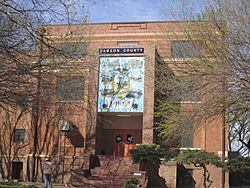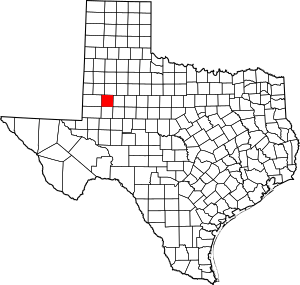Dawson County, Texas facts for kids
Quick facts for kids
Dawson County
|
|
|---|---|

The Dawson County Courthouse in Lamesa
|
|

Location within the U.S. state of Texas
|
|
 Texas's location within the U.S. |
|
| Country | |
| State | |
| Founded | 1905 |
| Named for | Nicholas Mosby Dawson |
| Seat | Lamesa |
| Largest city | Lamesa |
| Area | |
| • Total | 902 sq mi (2,340 km2) |
| • Land | 900 sq mi (2,000 km2) |
| • Water | 1.8 sq mi (5 km2) 0.2% |
| Population
(2020)
|
|
| • Total | 12,456 |
| • Density | 13.809/sq mi (5.332/km2) |
| Time zone | UTC−6 (Central) |
| • Summer (DST) | UTC−5 (CDT) |
| Congressional district | 19th |
Dawson County is a county in the state of Texas, United States. In 2020, about 12,456 people lived there. The main city and county seat is Lamesa.
The county was first created in 1876. It was officially set up in 1905. Dawson County is named after Nicholas Mosby Dawson, who was a soldier in the Texas Revolution. It is also the smallest Micropolitan Statistical Area in the United States, based on its population.
Contents
History of Dawson County
A different Dawson County was first made in 1856 from parts of other counties. But it was later divided up in 1866. The Dawson County we know today was created in 1876.
In 1943, a very important oil well was found in Dawson County. This well led to the discovery of the Spraberry Trend, which is one of the largest oil fields in the United States. The land belonged to a farmer named Abner Spraberry, and the oil field was named after him. Even though most of this big oil field is in counties to the south, a small part of it is in Dawson County. Oil production started in 1949, and by 1951, there was a big "oil boom" in the area.
Like all counties in Texas, Dawson County has a special way of being run. It has four commissioners, who are chosen by people in different parts of the county. There is also a county judge, who is elected by everyone in the county. This judge is the main leader of the county's government.
Geography of Dawson County
Dawson County covers about 902 square miles (2,336 square kilometers). Most of this area, about 900 square miles (2,331 square kilometers), is land. Only a small part, about 1.8 square miles (4.7 square kilometers), is covered by water.
Main Roads
Neighboring Counties
- Lynn County (to the north)
- Borden County (to the east)
- Howard County (to the southeast)
- Martin County (to the south)
- Gaines County (to the west)
- Terry County (to the northwest)
People in Dawson County
| Historical population | |||
|---|---|---|---|
| Census | Pop. | %± | |
| 1880 | 24 | — | |
| 1890 | 29 | 20.8% | |
| 1900 | 37 | 27.6% | |
| 1910 | 2,320 | 6,170.3% | |
| 1920 | 4,309 | 85.7% | |
| 1930 | 13,573 | 215.0% | |
| 1940 | 15,367 | 13.2% | |
| 1950 | 19,113 | 24.4% | |
| 1960 | 19,185 | 0.4% | |
| 1970 | 16,604 | −13.5% | |
| 1980 | 16,184 | −2.5% | |
| 1990 | 14,349 | −11.3% | |
| 2000 | 14,985 | 4.4% | |
| 2010 | 13,833 | −7.7% | |
| 2020 | 12,456 | −10.0% | |
| U.S. Decennial Census 1850–2010 2010 2020 |
|||
In 2000, there were 14,985 people living in Dawson County. The population density was about 17 people per square mile. Many different groups of people live here. About 48% of the population was Hispanic or Latino.
The average age of people in the county was 36 years old. About 25.6% of the population was under 18 years old.
The average income for a family in the county was about $32,745 per year.
Towns and Communities
Cities
- Ackerly (partly in Martin County)
- Lamesa (the main city)
- Los Ybanez
- O'Donnell (mostly in Lynn County)
Special Places
- Welch (a census-designated place)
Small Communities (Unincorporated)
Old Towns (Ghost Towns)
- Pride
- Sand
Education
Here are the school districts that serve students in Dawson County:
- Dawson Independent School District
- Klondike Independent School District
- Lamesa Independent School District
- O'Donnell Independent School District
- Sands Consolidated Independent School District
The county is also served by Howard County Junior College, which offers higher education.
See also
 In Spanish: Condado de Dawson (Texas) para niños
In Spanish: Condado de Dawson (Texas) para niños


